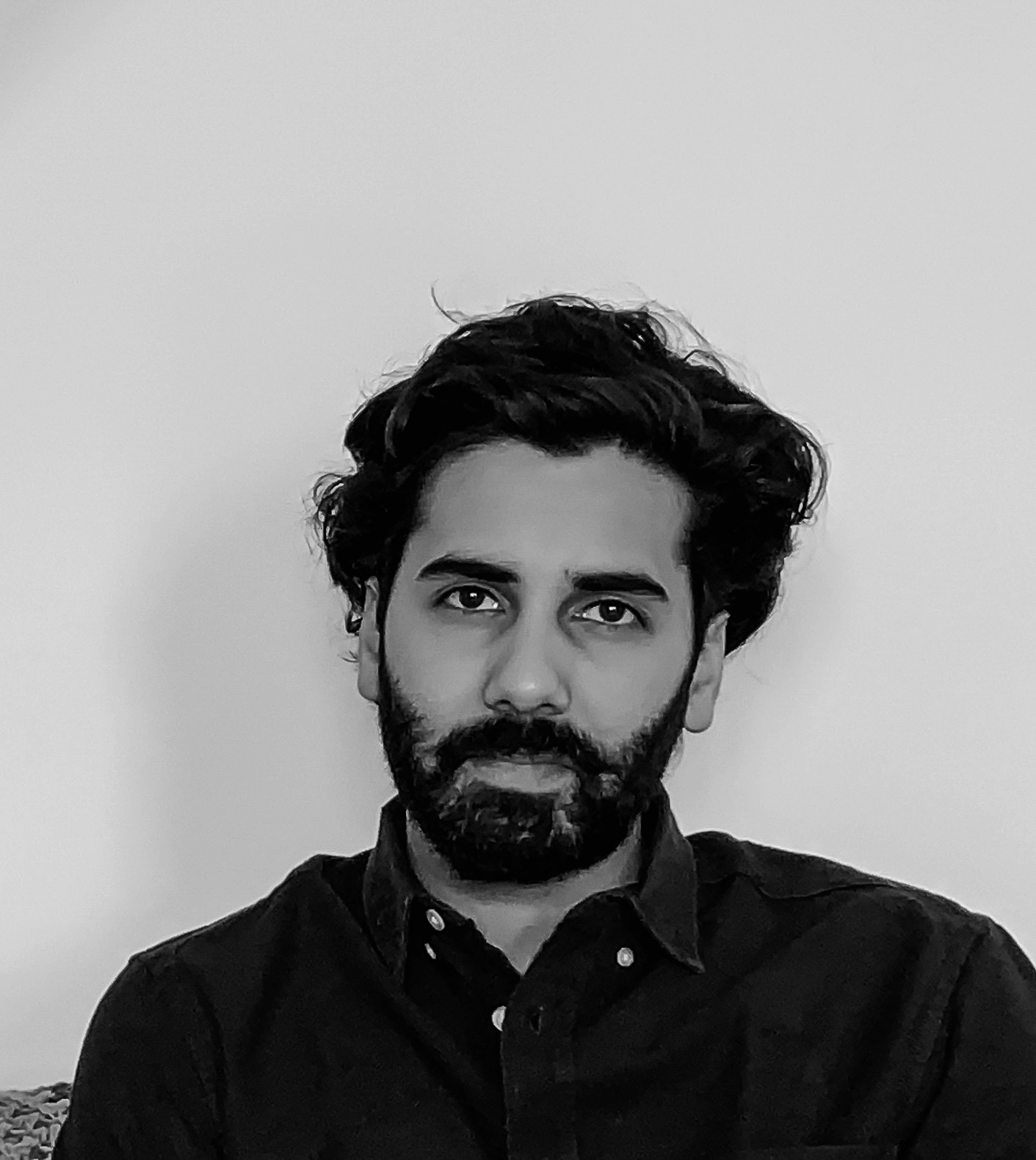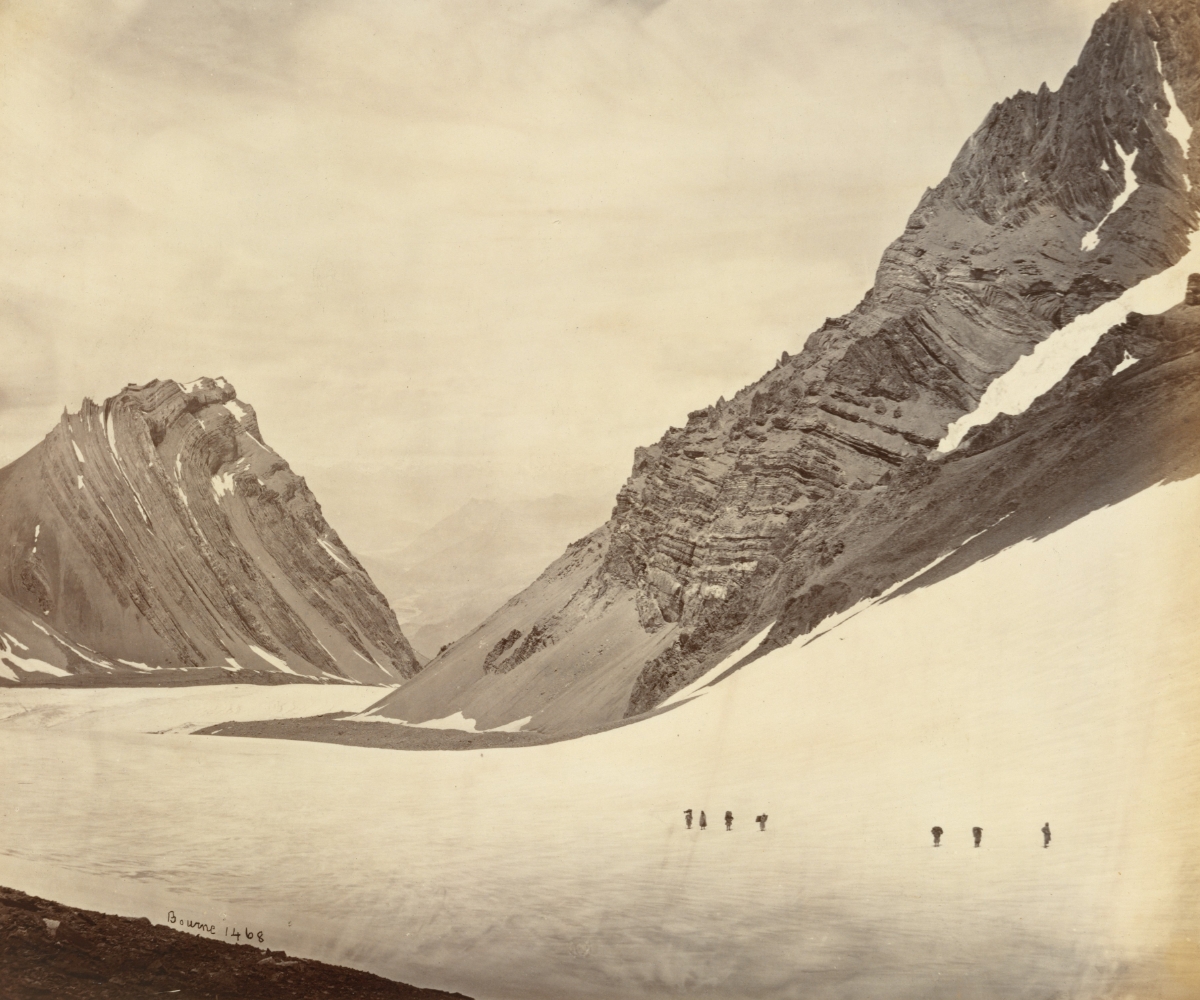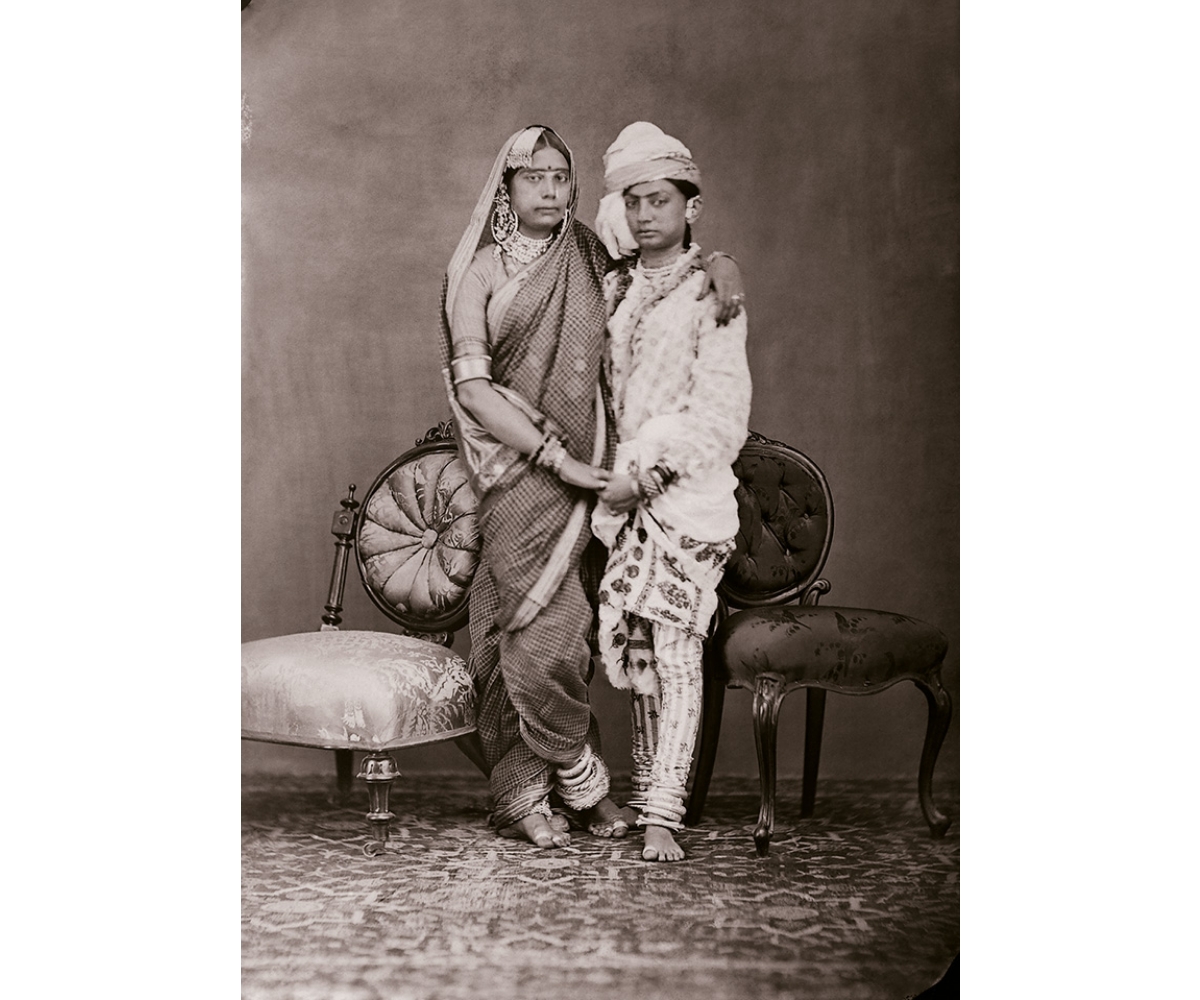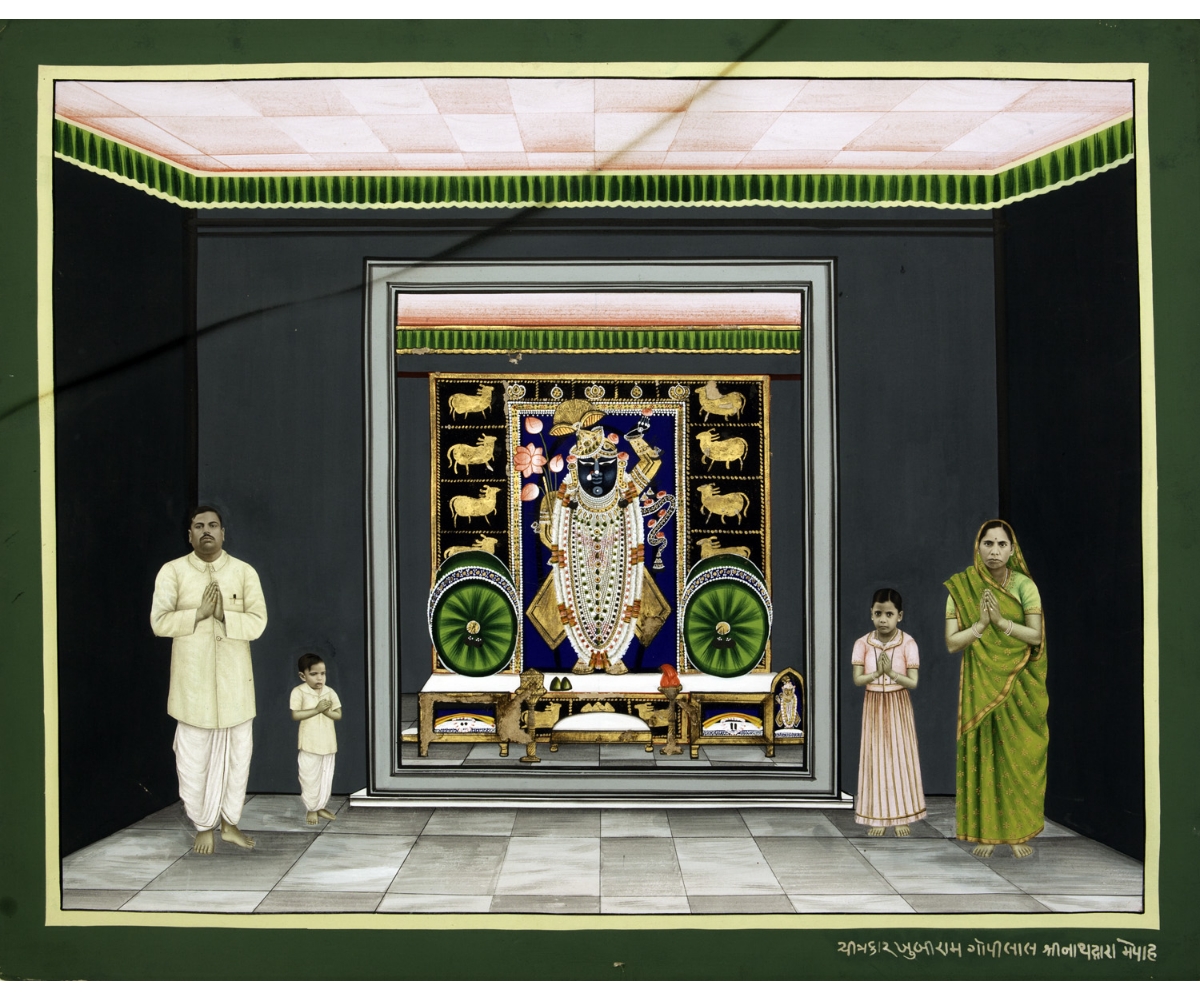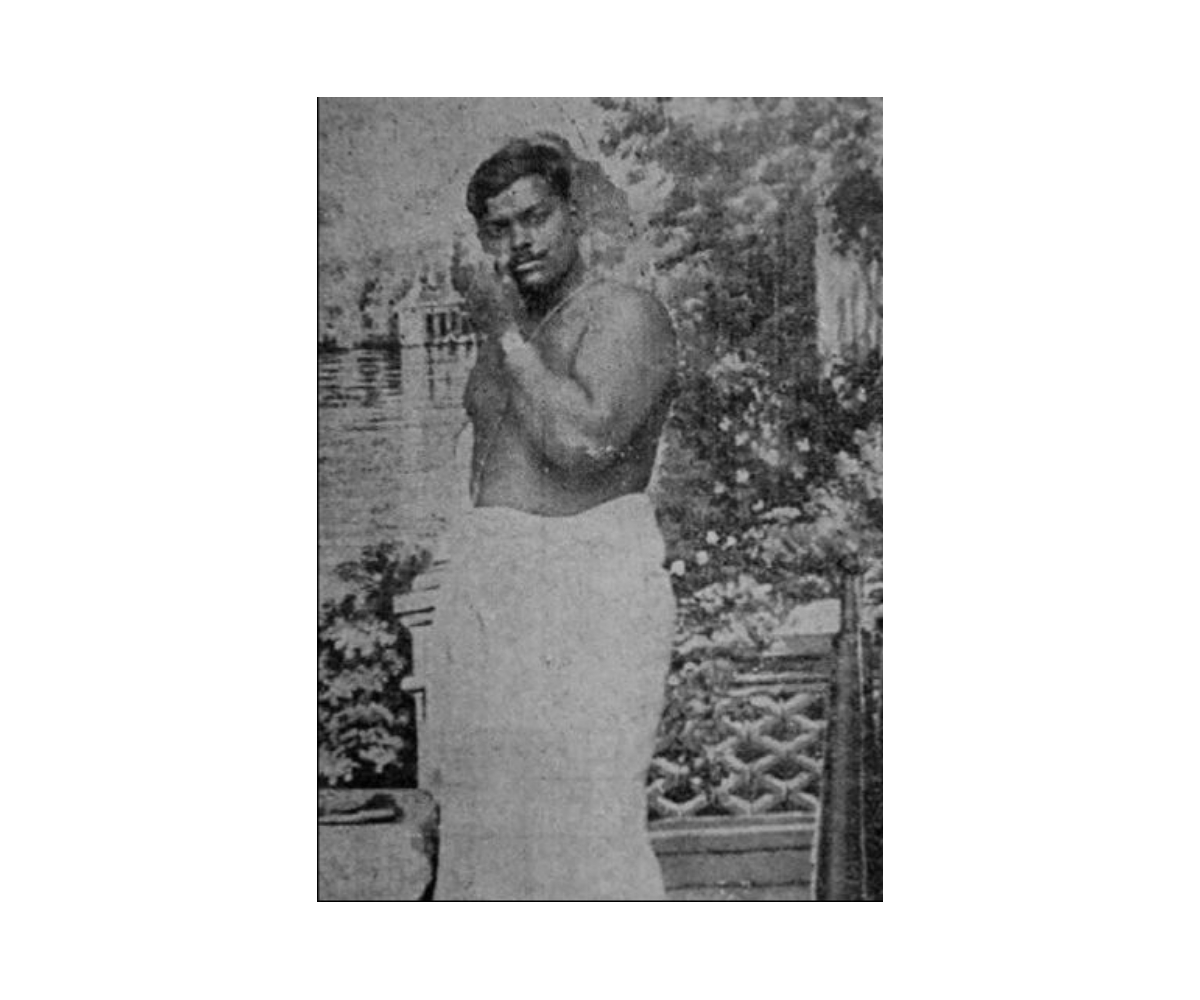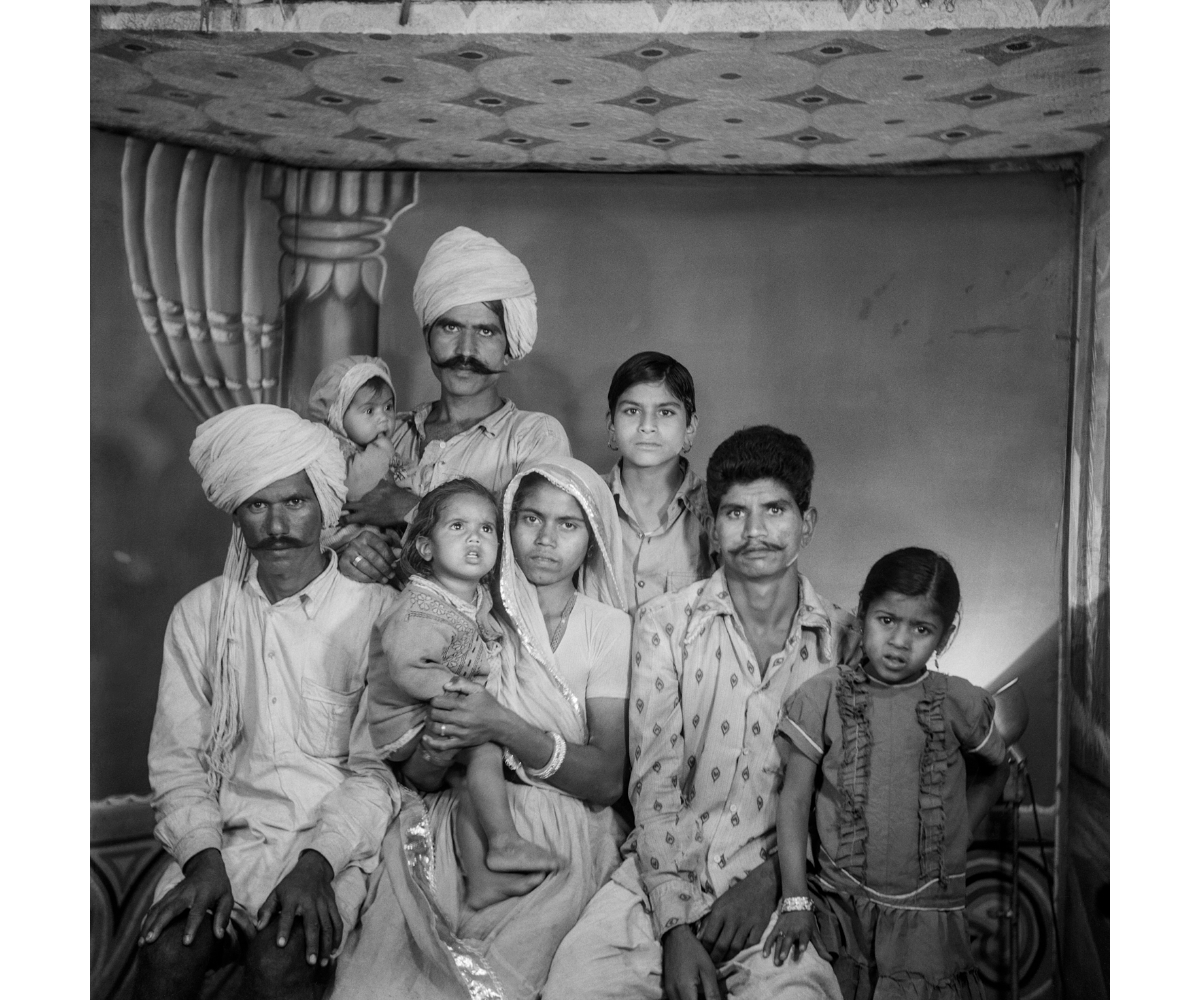STORIES
Interior Worlds: The Legacy of Studio Photography in India
In 1866, the reputed British photographer Samuel Bourne ventured into the Himalayas for his final expedition in India.
There, at Manirang Pass in the state of Himachal Pradesh, at an elevation of 18,600 feet, he waited for the clouds to clear before making one of his most famous images, wherein two jagged mountains protrude from a thick blanket of snow over which men the size of ants trudge laboriously.
By this time, Bourne had been in India for three years and had established two successful photography studios — first in Shimla in 1863 and then in Calcutta (now Kolkata) by 1866 — yet it was landscape views such as these that solidified his place in Indian photographic history. This picturesque white vista, however, conceals a deeper reality about the medium’s early history. Like most camera equipment at the time, Bourne’s was bulky and encumbered by a host of technological limitations, requiring him to travel with a small army of eighty porters, a darkroom tent, glass plates, several boxes of chemicals and even livestock. So ubiquitous today, photography was primarily the domain of the elite back then — in India, it necessitated having the specific kinds of access and capital upon which British colonial dominance was built.
The simple fact is that Bourne was an exception in his time and place; most photography was hardly being produced in such hostile environments. Nonetheless, when we think about photography and its history over the last two centuries, a certain set of assumptions emerge, chief among them the idea of the photographer as “venturing out,” with the camera being a mobile companion. To think of another way into this history requires some readjustments. Most photography, especially in its early decades, took place indoors and in a controlled space, centering around a relatively less-discussed institution, where a range of commercial interests, power relations and aesthetic ideologies converged: the photography studio. In mapping the medium’s history from the perspective of the Indian studio, Bourne’s image at Manirang Pass recedes from view, allowing a more complex story to take shape. From the postcolonial to the contemporary, the ever-changing role of the studio has been central to how we understand photography in India. In discussing studio photography along this historical arc, we gain a wider view of its history and how it’s embedded in particular social structures, commercial exchanges and popular attitudes.
Colonial origins
Ever since its invention in the 1840s, photography has had a formative relationship with the studio. Emerging during a time of great enthusiasm for European realism, early photographs of people were broadly considered to be an extension of painted portraiture. Soon after Louis-Jacques-Mandé Daguerre created the daguerreotype, studios equipped with the technology began appearing across Europe. By 1841, exposure times for photographs had shrunk significantly — in large part due to William Henry Fox Talbot’s invention of the calotype (paper negative) in Britain — allowing studios to mass produce and copy photographs for their clients. The medium’s technological practicality and easy reproducibility drastically reframed popular understandings of the portrait, the artist and the sitter, making the image both widely accessible and ripe for commercialisation.
This newfound accessibility was, of course, only part of photography’s larger appeal. Its realistic depictions made it a fitting expression of Victorian-era Britain’s preoccupation with order, rationality and scientific preeminence, both at home and across its expanding colonial empire. Photography’s introduction in India, soon after its proliferation in Europe, was prompted by both an anthropological desire and administrative necessity, to make a colony roughly thirteen times the size of Britain legible. The photograph was instrumental to colonial statecraft; it assisted in drafting urban plans, archived archaeological sites and supplemented written and drawn representations of India’s various indigenous communities. The men behind these cameras — and they were almost exclusively men — were seen less as photographers expressing creative autonomy and more as “photographer-administrators,” serving the broader political vision of the metropole. As a technology of governance, the ‘truth’ promised by the photograph interpreted India along a hierarchy predetermined by painters, archeologists and colonial officials — a place both ethnographically promising and rich in raw material for the imperial project.
It is interesting, then, to note that when photography in India acquired a commercial dimension through the emerging popularity of studios, these power dynamics were not simply reproduced but also reconfigured. Streaked though they were by colonial intent, studios also mirrored the localised commercial and social character of the cities where they first developed. One of the earliest was the photographer F Schranhofer’s calotype studio in central Calcutta in 1849, followed by a daguerreotype studio opened by Augustus G. Roussac in Bombay (now Mumbai) the next year. Though owned by Europeans, both businesses employed Indians as assistants, a practice that became increasingly common over the subsequent decades, establishing the foundation for greater local interest in the medium and the operation of studios.
By the mid 1850s, photography societies and amateur clubs had mushroomed in the three British Indian presidency towns — Bombay, Calcutta and Madras (now Chennai). The British civil servant and photographer William Johnson, who established a studio in Bombay in 1852, went on to become a founding member of the Photographic Society of Bombay two years later, serving as its joint-secretary and an editor and contributor for its journal, albums and exhibitions.
Johnson also worked alongside Dr. Narayan Dajee, one of many Indian council members of the society and a prolific photographer himself. On the other side of the country, the Photographic Society of Bengal was established in 1856 — with Indians comprising roughly a third of the total membership at the time — and organised its first exhibition the next year, featuring photographs from Dajee, among others. Around the same time, the Elphinstone Institution in Bombay and the Madras School of Industrial Art established photography classes attended predominantly by Indians. The pioneering early Indian photographer Hurrychund Chintamon was one of these students in Bombay, and went on to photograph many carte de visite portraits of European officials, travellers and Indian royalty, later establishing a studio of his own.
Gradually, a medium that arrived in India as an administrative tool was repurposed by the practices of a progressively diverse field of players, most of whom saw the studio as a site of aesthetic and commercial possibilities. Among the Indian-owned studios of the time, Lala Deen Dayal & Sons — established in Indore by the former public works department employee and pioneering photographer Lala Deen Dayal in 1874 — was perhaps the most prominent. Throughout the concluding decades of the nineteenth century, Deen Dayal served as an official photographer for several viceroys, made images for the Archeological Survey of India and was the court photographer for royalty such as Tukoji Rao II, Maharaja of Indore. Studios such as Deen Dayal’s allowed sitters a space to exercise a style of authority inspired largely by the visual codes of Victorian portraiture: most prominently, a centrally positioned three-quarter profile, lending richer dimensionality to the subject’s presence in the photographed space. It was this promise of representation that earned him greater commercial success, eventually helping him set up more branches of his studio in Secunderabad and Bombay.
By the time Deen Dayal’s commercial and patronised work was gaining prominence, Indian studio photographers had already begun meaningfully competing with their British counterparts. Despite some noticeable differences in choices of subject matter, studio portraits from these decades exhibit remarkable similarities in aesthetic approach. This was in large part due to the fact that upwardly mobile Indians and British colonial officers occupied the same institutional spaces where photography was being practised and discussed — societies, studios, journals and exhibitions. In many cases, they also had similar buying power.
Another prominent, though lesser-known, figure during these decades was the Maharaja of Jaipur, Ram Singh II, who ruled the city from 1835–80 and was fondly called India’s first “photographer-prince.” Many believe that he was first exposed to the medium by the British photographer T Murray, who visited Jaipur some time around the 1860s. Though he didn’t operate a strictly commercial studio, Ram Singh’s portraits were nonetheless meticulously arranged — like a true professional, he also kept a journal recording his observations.
Aside from many portraits of himself, visiting royalty (Indian and European) and some outdoor photographs of his princely state, he notably also made many portraits of the women who lived in his palace’s zenana, a set of rooms and courtyards in Rajput palaces reserved specifically for women. These women lived almost entirely out of the public view, and so, the act of photographing them was yet unprecedented. The portraits serve as unique records of the regime of invisibility and domesticity imposed on many Rajput women at the time, and draw heavily from European influences to express a reformist attitude towards traditional forms of representation. However, it must also be said that Ram Singh’s transgression of these social divisions was mostly limited to an aesthetic fascination. Despite their royal status, these women didn’t have much of a choice in denying his camera, and their names were never included in the final photographs.
What is clear from Deen Dayal and Ram Singh’s portraits is that it wasn’t uncommon to see Indian studio decorations draw from the style of Victorian interiors — ornate chairs and stools, painted backdrops and plush curtain drapes. The central position and angle of the sitter, too, conveyed a formality reminiscent of distinctly European attitudes toward portraiture. In much the same way that Ram Singh developed his artistic approach through varied foreign influences, the British-trained Parsi photographer and studio practitioner Shapoor Bhedwar expressed his own relationship to the visual language imported from Europe. Working in the waning years of the nineteenth century, Bhedwar’s strategically lit, soft-focus images possess a painterly quality that exceeds the utilitarian limitations of the photographic portrait as a document of likeness. Most notably, Bhedwar’s work exhibited a deep interest in the Western-originated vocabulary of photographic pictorialism, “which championed the ‘creation’ rather than the ‘taking’ of an image and, crucially, the photographer’s self-labelling as an artist.”
More broadly, the conception of the photographer as artist — and, consequently, the studio as creative space — only gained greater popularity at the turn of the century and the decades thereafter, as photographic technology became relatively more affordable and less cumbersome. Within the first half of the twentieth century, there were thousands of studios scattered across India. Photography’s growing accessibility, both for potential clients and aspiring studio photographers and owners across India, had an interesting effect on the ways in which European visual influences were brought into the space of the Indian studio. A significant example of this effect was painted photography — originally a style of embellishment for late-nineteenth century court photographs that made its way into smaller studios serving a more general clientele in the twentieth century. The technique’s compositional mix of European portraiture as well as Mughal and Rajasthani miniature painting signalled a general ambivalence, in which local, commercial and cultural modes took precedence over a fidelity to any single dominant artistic tradition.
For instance, starting in the 1920s, the photographer and painter Khubiram Gopilal worked out of a studio near the Shrinathji Temple temple in Nathdwara, Rajasthan, where artists sold painted mementos for visiting pilgrims. In his adaptation of the popular manorath (mind’s vehicle; desire) paintings — a tradition that held deep personal significance for worshippers looking to have their presence in the temple represented affordably as souvenirs — Gopilal worked with local artists who hand-painted devotional scenes and then cut-and-pasted faces from photographs of his clients onto the paintings.
This approach of mixing painting and photography wasn’t new for Nathdwara, which had also been home to artists such as Ghasiram Hardev Sharma, who painted over European-style portrait photographs of his clients, again mostly religious pilgrims, as souvenirs in the late-nineteenth century. However, Gopilal’s later cut-and-paste paintings made this form of self-depiction affordable to a much larger clientele.
Aside from these specific and culturally situated studios, there were also many roadside photography studios — often called jhatpat (instant) studios — that had gradually been growing in usage in the first few decades of the century. Much like the wooden Afghan cameras that dotted the streets of Kabul during this period, Indian jhatpat studios typically used a box camera with an in-built ‘lab’ where photographic paper was exposed, developed, rinsed and sold on-site. The clients that frequented these studios were almost always middle and working class Indians who didn’t have access to a full urban studio and needed their portraits made, typically for administrative purposes. Unlike many of the photographers mentioned so far, jhatpat studio operators saw their work more as a vocation than an artistic practice; offering their customers an immediate service that mirrored the appeal of the polaroid, which would gain prominence globally a couple of decades later.
In the following decades, as photography became more prominent in varied contexts — from the courtroom to the roadside — and anti-colonial movements across the nation gained political energy, studios also acquired an added dimension. In some instances, they were used as tools to stage a direct contestation of British colonial presence in the subcontinent. It was not uncommon for anti-colonial freedom fighters to use the legitimising frame of portraiture to solidify support for their cause in the public consciousness. Members of the Hindustan Socialist Republican Association (HSRA) would often have their photos taken in studios before protests and missions that deviated from mainstream Gandhian non-cooperation and put their lives at risk.
Perhaps the most well-known of these were the studio portraits of Bhagat Singh and Chandrashekhar Azad — both young men who died in revolt — which iconised them as martyrs and “powerfully captured the romance of revolutionary life.” While both portraits are incontestably realistic depictions, each of the men it represented can also be seen to self-consciously accentuate themselves and embody the revolutionary spirit of the HSRA, hoping it will outlive them. Singh’s tilted hat and cold stare and Azad’s dhoti, wristwatch and moustache-twirl became instantly recognisable symbols of India’s anti-colonial struggle, replicated in posters, paintings and, in some cases, printed in newspapers.
In contrast to the conventions of studio portraits as objects of private possession, interpersonal exchange, administrative usage or colonial ethnographic study, Singh and Azad’s photographs expressed a broader objective: they were portraits made with the intention of dissemination, not ownership.
Postcolonial shifts
By the mid-twentieth century, as the anti-colonial movement ended and India gained independence from British rule, the evolution of commercial studio photography experienced a split trajectory. While the gradual miniaturisation of cameras allowed more of them to proliferate, they were still notably expensive for most. Private ownership of cameras was most common in urban India, where the independence struggle from the previous decade or so brought politics, protest and diplomacy into the public sphere and engendered a greater interest in photojournalism.
Pioneering photographers such as Kulwant Roy and Homai Vyarawalla had already been practising for a number of years by this point, covering figures such as Jawaharlal Nehru, MK Gandhi and Muhammad Ali Jinnah for the national press. They were followed by a younger generation that included Raghu Rai, Pablo Bartholomew and TS Satyan, who — along with a number of other postcolonial artists across India — became increasingly engaged in photography’s capacity to express the country’s cultural history — its political present as well as its modernist aspirations.
Running parallel to this development, photographic studios were pushed deeper into rural and small-town India, where they continued to enjoy a steady clientele who were themselves experiencing the flux of a modernising economy under then-prime minister Nehru’s vision for the country. Within the thousands of photography studios in operation across India in the late decades of the twentieth century, the image was still a vehicle for posterity and performance; a medium of personal representation, administrative documentation and local exchange.
Business was almost exclusively determined by the spate of religious ceremonies, festivals and weddings throughout the year, in addition to the occasional administrative photograph — all of which occasioned visits to local studios. Arranged marriages, in particular, generated an economy of images that was especially well served by photography studios. This included producing photographs of unmarried and eligible men and women for circulation in and beyond the community, wedding-day photographs and even family portraits after the birth of the first child. Communal and family-focused religious events such as Raksha Bandhan and Karva Chauth among Hindus and Eid among Muslims also prompted studio visits and continue to do so.
Despite the studio being a colonial import, the aesthetic choices made by many small-town studio photographers were generally unconcerned about explicitly replicating or resisting Western influences. For them — many born around the time of Independence — the construction of the photographic space was both inherited from but also indifferent to its historical baggage. The use and manipulation of painted backdrops exemplifies this ambivalence. Popularised in the nineteenth century as signifiers of scenic beauty, and the sitter’s authority within it, painted backdrops were also frequently deployed in studio photography after Independence. However, the ideals expressed by these backdrops were also re-situated within the context of a new, postcolonial India and its modernising ambitions. The picturesque became one of many visual components in the studio, alongside telephones, radios, magazines and even cameras, objects that expressed “an alignment with a modernity characterised by the consumption of advanced forms of communication and travel.” In the space of the studio, an aspirational and self-sufficient India was being sketched atop older relations of power and representation, resulting in overlapping influences that were varied and evolving in their selection of sources.
The emergence and growing commercial popularity of India’s post-Independence film industries had a consequential role to play in the evolution of the aesthetics adopted by photography studios in the second half of the twentieth century. In the Hindi Belt, for instance, the social realist mode of the 1950s and 60s had given way to a more extravagant visual style that offered new referents from which photographic spaces could be constructed. For sitters, the sense of being a protagonist in these spaces — intuitive to the process of portraiture — gained a more concrete and identifiable form in the culture they consumed with greater regularity. In rural and small-town India especially, filmic aesthetics spilled far beyond cinema halls and suffused many aspects of commercial life, from posters to commercial packaging. The world of films was everywhere distinctly recognisable but always slightly out of reach, charged with the quality of dreams and the otherworldly, where protagonists were rendered ‘stars.’
Capitalising on this opportunity and its commercial and creative potential, many studios advertised a sense of access to cinematic forms of self-presentation. Lights were strategically positioned to accentuate shadows and suggest moods; negatives were also often manually edited, treated and superimposed to create photo montages and other abstract effects. Many of these photographic arrangements were inspired by film lobby cards, which often succinctly conveyed both the visual approach of a particular film as well as its main narrative concerns such as family dramas, romance or age-old confrontations between good and evil.
Contemporary reflections
Towards the early 1990s, as the Indian economy liberalised, foreign cameras — especially from Japan and Germany — began entering the domestic market in greater numbers. This was also around the time when digital cameras were becoming increasingly popular. Many photography studios, keen to expand their services and worried about their obsolescence, adopted new technologies with enthusiasm. However, digitisation meant that buying a personal camera, now more portable and affordable than ever, was no longer the sizable investment it used to be. As a practice so deeply entrenched in physical spaces, both creative and commercial, studio photography began to decline sharply after the turn of the century, even as digital cameras were further miniaturised into camera phones.
Today, the life cycle of an image, from production to storage to exchange, is almost entirely digital and occupies little concrete space. While this has given even greater portions of the Indian population access to photographic self-expression, it has also continued to transform the ways in which studios operate as businesses. For commercially franchised and independent studios alike, physical spaces have increasingly become the sites of image processing and not necessarily image making. Depending on their ability to adapt, they’ve had differing fates. The trajectory of the 120-year-old Bengaluru studio GK Vale & Co, for instance, mirrors many studios that have managed to remain profitable across India. Having initially serviced Karnataka’s elite in the early twentieth century, the studio eventually became one of the first to introduce colour photography in South India in the 1970s. Having expanded across dozens of shops across the state, the franchise has managed to stay afloat primarily due to its technological acuity, having gradually supplemented their business with a number of additions including printing, framing and e-commerce. Those who have not adapted to these shifts have unfortunately become historical artefacts from an era that feels further in the past than it actually was.
In June 2016, Kolkata’s iconic Bourne & Shepherd, until recently one of the longest running studios in the world — established by Samuel Bourne and Charles Shepherd — shut down after nearly 176 years, when its last owner Jayant Gandhi lost a 14-year legal battle for the building to a state-owned insurance corporation, citing the stress digital photography placed on the business.
Mumbai’s Hamilton Studios, founded by the businessman Victor Sassoon in 1928 and once considered “official photographers of the Bombay state,” has historically entertained a range of elite clientele, from the colonial aristocracy and prominent postcolonial figures to Bollywood stars. Now run primarily by Ajita Madhavji — whose father Ranjit, a cloth merchant, took over the business from Sassoon in the 1950s — the studio has witnessed a spate of technological changes. Consistent with the studios that developed alongside it in the century prior, Ajita has hand-painted Hamilton’s backdrop and takes a slow and meticulous approach to setting up the photographic space. Her father once had a strict ‘no digital cameras’ policy, but Ajita, initially refusing to offer her printing services for images taken on camera phones, has had to relent to keep the business running, recently having added a Nikon D750 DSLR to her arsenal. “The studio has an account on Instagram now,” she recalls further. “I update it every few weeks. We have to go with the flow.”
Despite these changes, commercial pressures and closures, there has recently also been a proactive effort on the part of art historians, anthropologists, curators and photographers to engage with local photography studios, both as historically significant spaces and as sites where a number of distinct aesthetic approaches emerged. The anthropologist Christopher Pinney, for instance, has done a significant amount of field work and archival research focused on photography studios in small town Madhya Pradesh. Similarly, the social anthropologist Zoé E Headley has worked specifically on studio photography from Tamil Nadu, founding the STARS Archive, a research collective focused on preserving and archiving photographs from twentieth-century studios across the state.
Indian photo studios have also been repurposed and reinterpreted by various photographers interested in various aspects of its history of representation and visual possibilities. Ketaki Sheth’s 2018 exhibition and book Photo Studio collects and displays images she made in small, twentieth-century studios across India, mixing her own visual style with each owner’s photographic space. While the project aims to highlight what she sees as a forgotten aspect of Indian photographic history, her outwardly nostalgic approach also reaffirms her — and our — distance from this history, resulting in images that read as both celebrations and eulogies: “It was my job to capture…that decayed crease in a curtain,” she writes.
In another example, the artist Pushpamala N, in collaboration with the UK-born, Bengaluru-based photographer Clare Arni, takes a different approach to her project Native Women of South India: Manners and Customs, 2000-2004, which deconstructs a much older function of the photographic studio: colonial ethnography. Comprised of “fantasy” studio photographs, the project features Pushpamala in the role of the sitter, deliberately uncovering the artifice of the colonial gaze through a pronounced and nakedly satirical style of photo-performance. In this case, the imbalance of power and representation formerly present in colonial-era studios is destabilised through a kind of conceptual playfulness. The studio space, in this treatment, is less a subject of cultural nostalgia and more a medium of critique — a visual component of the new rather than merely a record of the old.
To revisit Bourne’s image at Manirang Pass in light of this new context, a veritable split in the history of photography becomes apparent. Technological shifts have ensured that making such an image today is significantly simpler, even though the Pass has not become any less treacherous or beautiful. But upholding the original as the only exemplar of what has made photography in India special bypasses its material history of the last two centuries. It is, infact, this materiality — lost in how photography has been historicised in the country — that makes this intervention crucial. The studio has lived many lives in its near-two centuries in India, serving a range of objectives: colonial, administrative, revolutionary, commercial, personal, aspirational and conceptual. The more we look into this history, the more we see that no story of photography in India is complete without the story of its studios, their evolution and their enormous, unseen archives. In 1976, the renowned American photographer and curator John Szarkowski wrote: “The world now contains more photographs than bricks, and they are, astonishingly, all different.” To repurpose this sentiment: each Indian studio is astonishingly distinct, housing histories that live beyond the grip of canonising institutions. Enlarging the possibilities of photography’s much-narrated exteriority is the parallel and equally significant interiority of the studio — each containing a world of its own.



